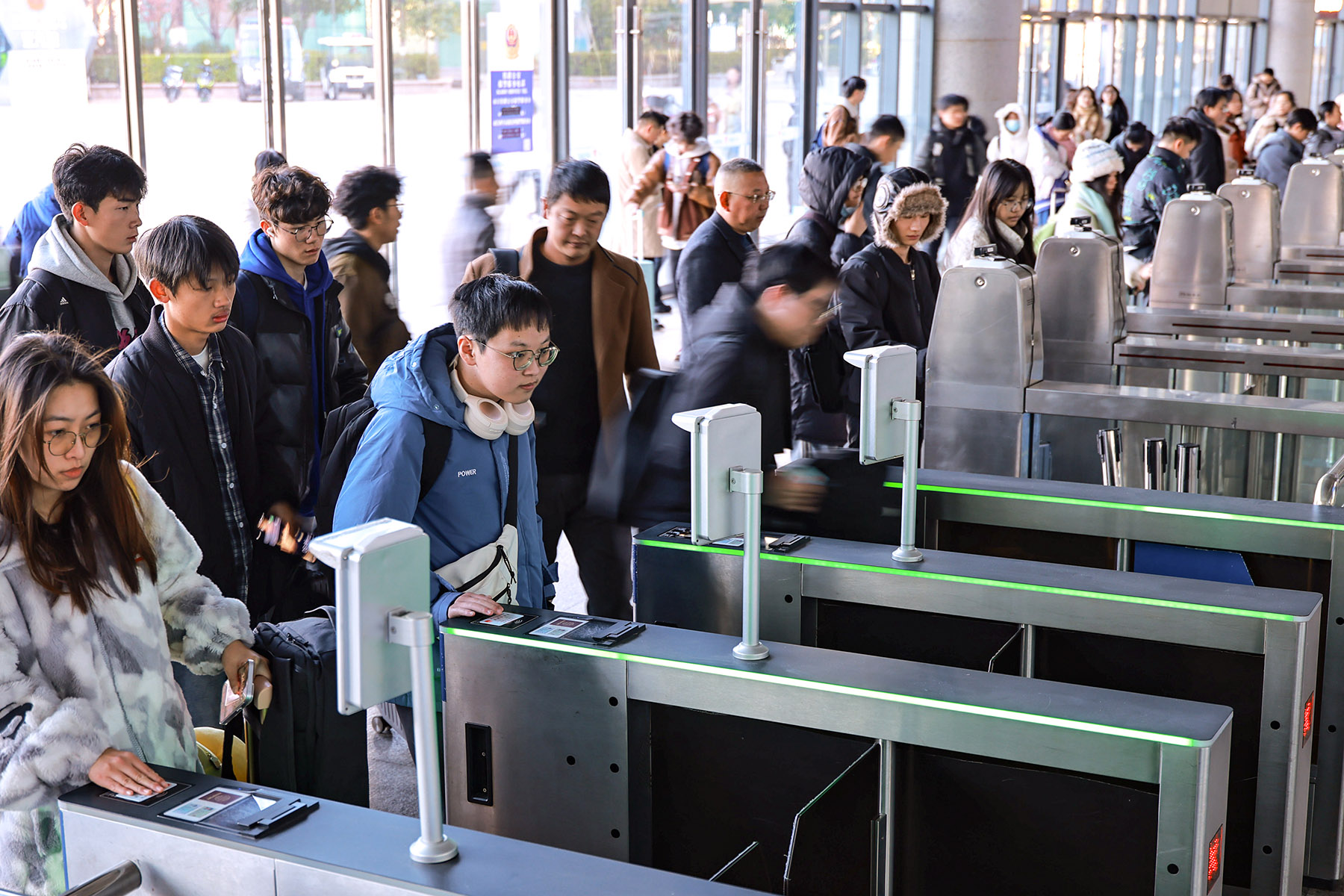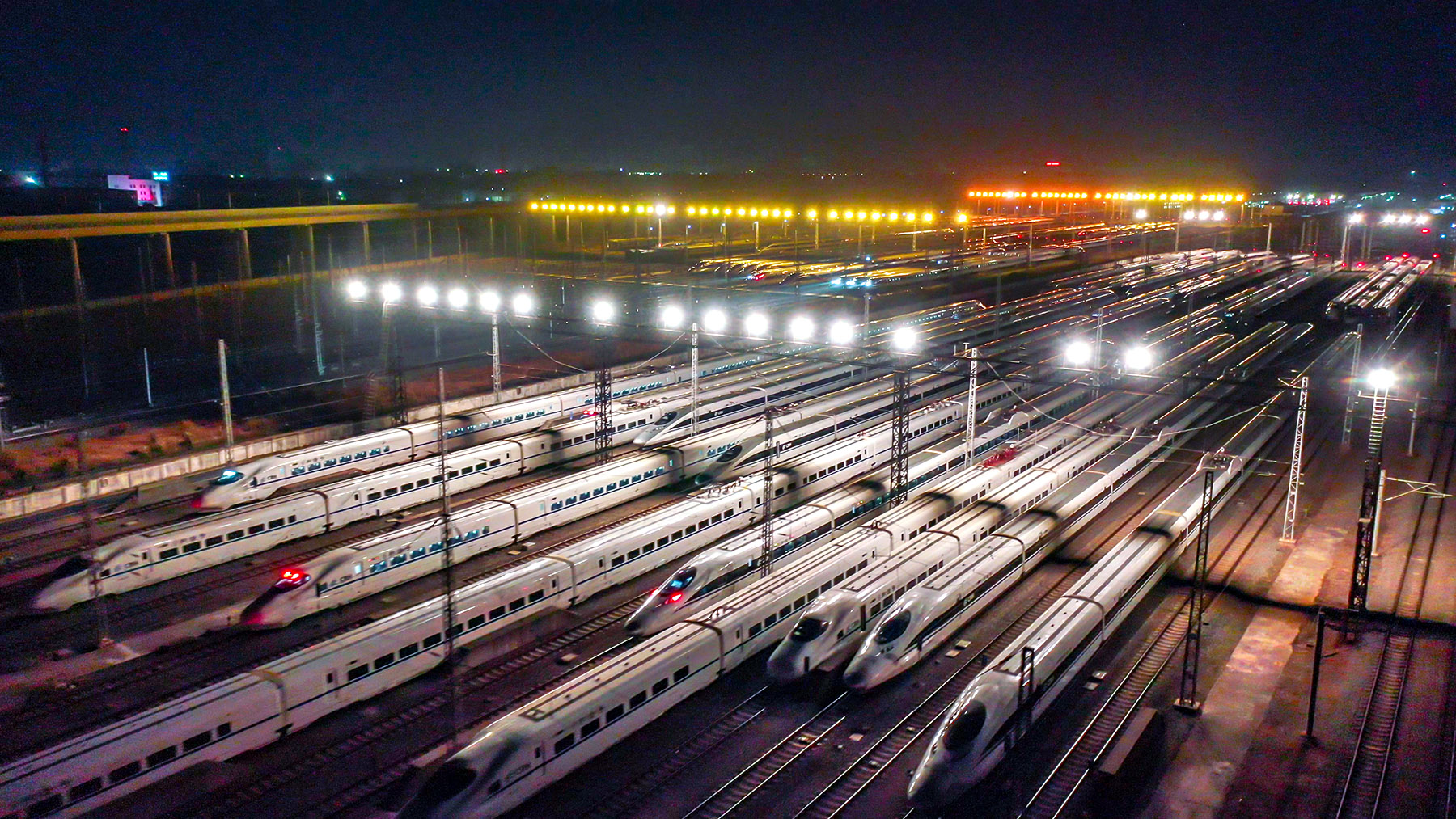Crowded aisles and slow rides become a distant memory

For 75-year-old Zhang Kunming, the Spring Festival travel experience has been indelibly engraved in his memory. In 1973, as he embarked on a creaking, slow green train from the then-bustling industrial city of Shenyang in northeastern China's Liaoning province to his native Shandong province in eastern China, Zhang encountered conditions that are now scarcely imaginable.
"Back then, I endured three arduous days on a train with no assigned seats, and the aisles were jam-packed with people, like sardines in a can," he recalled vividly. Every bit of space was occupied by fellow travelers, and even the most basic task — such as using the cramped, far-off toilets at each end of the carriage — turned into a major ordeal.
Zhang's arduous journey was a test of endurance and determination, in which the travel experience itself was the most significant challenge.
"Going home for Spring Festival is a tradition passed down by our ancestors," he said, echoing the deep-seated yearning shared by countless Chinese people.
READ MORE: Chunyun: Tradition on the fast track
At that time, it had been his fourth year away from home, working and studying in Shenyang, but the first time he was returning for the Spring Festival reunion. Although the reunion came at a steep price — a three-day, bumpy train ride that cost him approximately three months' salary of 18.70 yuan — Zhang's resolve remained unwavering.
"There was no alternative," he said, recalling the chaos when the gates opened and every person surged forward, propelled by a desire to be with their families. His recollection of writing weekly letters to ease the painful separation painted a vivid picture of a time when every journey was an act of faith and a testament to the unwavering pull of home.
Fast forward to more recent times, and the transformation in China's transportation landscape has been nothing short of astonishing. Now, Zhang either travels to Beijing to celebrate the festival with his son's family or welcomes them at his home in Shandong, a trip that only takes three hours.
"Tickets from Beijing to Shandong could be hard to come by, and sometimes I needed to adjust my schedule. But tickets from Shandong to Beijing were readily available. Moreover, ticket prices were very reasonable. With my pension of 8,000 yuan ($1,103), a high-speed train ticket to Beijing costs just over 300 yuan. I could travel whenever I wanted," Zhang said.
Compared with his previous experiences, Zhang described his new journey as a luxury.
"It was a mere three-hour bullet train ride on a comfortable and clean train — travel for reunion has become an enjoyment," he said.
"Although sometimes I have to snap up tickets on my phone, I am quite proficient at it. Compared to paper tickets, booking on my phone has been incredibly convenient. In the past, I had to bring a small stool to the station and line up overnight. China has truly developed."
Zhang's experience mirrors the nation's rapid development and the substantial improvements in people's quality of life. His experiences during the Spring Festival travel season — known as chunyun — vividly illustrate the profound changes in China's transportation system over the decades, and serve as a testament to China's progress, reflecting infrastructural advances and evolving lifestyles.

Development meets demands
China's Spring Festival travel rush usually lasts for 40 days, and began this year on Jan 14. It is the world's largest annual travel season, with 9 billion trips expected to be made.
Railway transportation has always drawn the greatest attention during chunyun since it's a traditional way for people to move across the country compared with flying or driving. This year, a record 510 million trips are expected via the railway network.
Ji Jialun, a distinguished professor from Beijing Jiaotong University, said: "The rapid development of the railway, especially after the construction of high-speed rail dedicated to passenger transport, has greatly alleviated the pressure during chunyun. Previously, freight and passenger services shared the same tracks."
In 1978, China's railway network spanned 52,000 kilometers, with no high-speed rail. By the end of last year, the network had expanded to 162,000 km — 48,000 km of which were high-speed rail, forming the world's largest high-speed rail network. This transformation significantly eased travel pressures.
During this Spring Festival, over 14,000 train services operated daily, providing an extra 500,000 seats per day — a 4 percent year-on-year increase, according to China State Railway Group, the national railway operator.
Zhou Changfeng, an official from the group, said: "We made advance preparations, scientifically arranged transportation capacity, improved service quality, strengthened safety measures and enhanced emergency response capabilities."
He also mentioned that passenger capacity on popular routes had been increased through additional trains and nighttime services.
During this year's festival, Beijing West Railway Station, one of the busiest stations in the country, installed 82 additional signs to streamline transfers. More staff were deployed at platforms and exits to monitor peak-hour traffic and ensure smooth passenger flow. Close coordination with local transport authorities led to increased taxis and ride-hailing vehicles, particularly for late-night arrivals, ensuring travelers reached their destinations seamlessly.
Meanwhile, Beijing Chaoyang Railway Station introduced information cards detailing routes to other major stations, opened an express entry hall and operated four fully-staffed entrances during peak hours to allow passengers to board trains efficiently. Additional personnel were deployed to assist elderly travelers and families with children.
A traveler can even order food via the 12306 system and have it delivered directly to their seat.
Zhang recalled: "In the past, meals on the train were very basic. Although there was a dining car, most people were reluctant to spend money. I just ate steamed buns with pickled vegetables, and even brought enough food to last for days."
Train stations have undergone significant improvements. Beijing West Railway Station now features a special waiting lounge that includes a children's play area, a parental care zone, a tailored waiting section for senior travelers and a specially designed area for passengers using wheelchairs.
Easier ticket purchasing
Although travel has become more comfortable, the shortage of tickets remains one of the main concerns during chunyun. For years, the difficulty of snapping up a ticket was a subject of popular searches on China's social media platforms. The hardships that had once plagued many Chinese travelers were greatly alleviated with the launch of the 12306 online booking system. Gone were the days of lining up overnight for a ticket.
The 12306 railway ticketing system has become the world's largest real-time ticket transaction system. At peak times it issues over 1,000 tickets per second, allowing users to complete their purchase in just 1.2 seconds.
Yan Zhiyuan, a researcher at the China Academy of Railway Sciences, said that his team has expanded internet bandwidth to handle increased traffic, strengthened cloud-based query capabilities, enhanced transaction processing capacity for massive ticket sales and curbed third-party ticket scalping — all aimed at ensuring fair, organized and user-friendly booking.
Wang Youni, a duty stationmaster at Beijing West Railway Station, recalled how ticket halls once teemed with people sitting on small stools for hours.
"Now, there is no need for that. Everyone can buy tickets on their phones. In the past, people would have lined up all night, and even then they weren't guaranteed a ticket," she said.
"Now, stations are much safer. My child was in college and sometimes traveled during chunyun for tourism. Of course, as a parent, I still worried — but it was a different kind of worry. It was no longer about safety like before," she said.
A reflection of modernization
Ji from Beijing Jiaotong University said, "Railway Spring Festival travel is a mirror reflecting the trajectory of China's development in recent years."
Xie Yurong, a researcher from the Academy of Macroeconomic Research, said that the very existence of the Spring Festival travel rush had been a reflection of China's modernization process.
ALSO READ: CNY travel: 4.8 billion domestic trips estimated taken over Jan 14-Feb 2
"It continuously drove the development of chunyun while serving as a massive real-world application scenario that propelled progress in transportation infrastructure, technological advancements and service innovations," she said.
She likened chunyun to a stress test for the transportation system, simulating extreme scenarios that challenge infrastructure and logistics.
"Currently, one common complaint during the travel rush is the difficulty of managing large bags, especially at railway stations that still lack escalators — forcing passengers to carry heavy luggage up and down stairs," she said.
"As people's expectations rise, improvements should be made with a people-first approach, paying attention to these finer details."
Zhang marvels at China's rapid advancements in high-speed rail.
"At the end of last year, I read the news about the new prototypes of faster bullet trains traveling at 400 km an hour have been released. Maybe in my lifetime, I could get to ride an even faster train. Then I can travel for a reunion with my son in maybe under two hours," he said.



